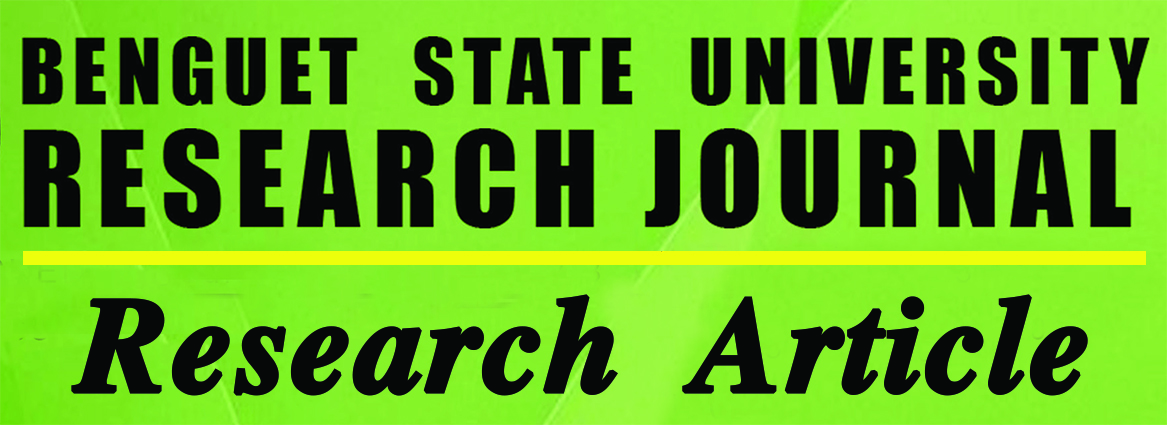Reproduction of Root Knot Nematode (Meloidogyne Incognita) on Potential Tomato (Lycopersicum Esculentum) Cultivars and Breeding Lines
Main Article Content
Abstract
Two tomato cultivars and five (5) potential breeding lines from the Institute of Plant Breeding (IPB), UP at Los Banos, College, Laguna were evaluated under greenhouse conditions to determine the reproduction of root knot nematode, Meloidogyne incognita (Kofoid and White,1919). Reproductive factor (Oostenbrink, 1966) (Rf=Pf/Pi) was calculated for each cultivar/ breeding line. The breeding lines S602 and S610 supported lower population densities of M. incognita but they did not differ significantly with S611 and S608. The highest reproductive value was recorded in Apollo with 19.30; however, it was comparable to Anath and 20-05, with 15.30 and 15.17, respectively. Based on the criteria proposed by Robinson (1980) all the tomato cultivars and breeding lines tested are considered efficient hosts of M. incognita. However, additional trials are recommended to have more conclusive results.
Article Details
References
BARHAM, W.S. N.N. WINSTEAD. 1957. Inheritance of resistance to root knot nematodes in tomatoes. Proceedings of the American Society for Horticultural Sciences 69: 372-377.
DAVIDE, R.G., & J.R.DEANON,JR. 1967. Reactions of various breeding lines of tomato and ampalaya to Meloidogyne incognita. Philippine Phytopathol. 3:4-5.
DUCUSIN, A.R. & R.G. DAVIDE. 1971. Meloidogyne incognita: Its effects on tomato yield and some methods of control. Philippine Agr. 55: 261-281.
FASSULIOTIS, G. 1979. Plant breeding for root knot nematode (Meloidogyne Spp.) systemics, biology and control, ed. F. Lamberti and C. E. Taylor. 477 pp.
GILBERT J.C, & D.C. MCGUIRE, 1957. Inheritance of resistance to severe root knot from Meloidogyne incognita in commercial type tomatoes. Proceedings of the American Horticultural Sciences 68:437-42.
JACQUET, M., M. BONGIOVANNI, M. MARTINEZ, P. VERSCHAVE, E. WAJNBERG &P.CASTAGNONE-SERENO. 2005. Variation in resistance to the root knot nematode, Meloidogyne incognita in tomato genotypes bearing the Mi gene. Plant Pathology 54: 93-99.
JONES, F. G. W. 1956. Soil populations of beet eelworm (Heterodera schacctii, Schm.) in relation to cropping microplot and field plot results. Ann Appl. Biol.44:25-56
MADAMBA, C.P., J. N. Sasser, and L. A. Nelson. 1965. Some characteristics of the effect of Meloidogyne spp. on unsuitable host crop. N. C. Agric. Exp. Stn. Tech. Bull. 169:1-3.
REYES,T.T. AND L.M.VILLANUEVA.1981. Screening of crop varieties for resistance to Meloidogyne incognita: Vegetable Varieities. Proceedings of the Third Research Planning Conference on Root-Knot Nematodes, Meloidogyne spp. International Meloidogyne Project . Contract No. AID/ta-c-1234. 76-79.
ROBINSON, R. A. 1980. New Concepts in Breeding for diseases resistance. Annu. Rev. Phytopathology18:189-210 .
SMITH, P.G. 1944. Embryo culture of a tomato species hybrid. Proceedings of the American Society for Horticultural Sciences 44: 413-416.
WILLIAMSON, V. M. and R. S. HUSSEY. 1996. Nematode pathogenesis and resistance in plants. Plant Cell 8:1735-45.

